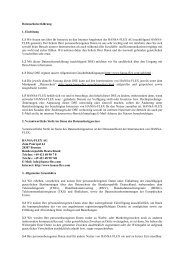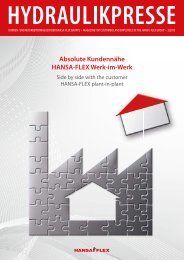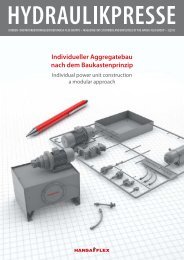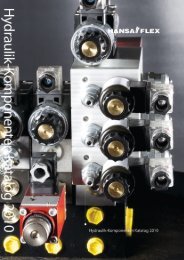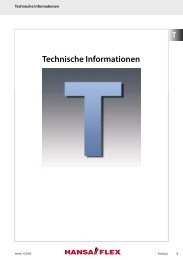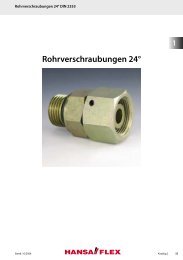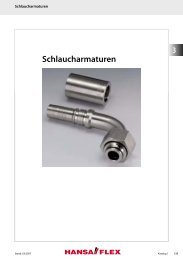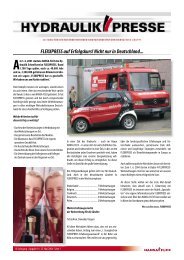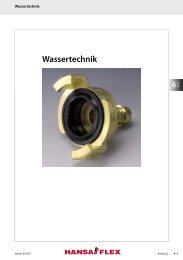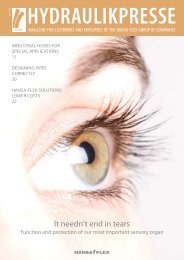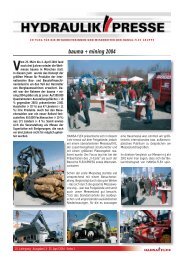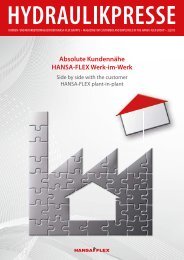HYDRAULIKPRESSE 4/2012 - Doppelseiten - Hansa Flex
HYDRAULIKPRESSE 4/2012 - Doppelseiten - Hansa Flex
HYDRAULIKPRESSE 4/2012 - Doppelseiten - Hansa Flex
Erfolgreiche ePaper selbst erstellen
Machen Sie aus Ihren PDF Publikationen ein blätterbares Flipbook mit unserer einzigartigen Google optimierten e-Paper Software.
Foto/photo: erKa pfahl gmbH<br />
PRAXIS praCtiCaL<br />
VON GRUND AUF SICHER<br />
SAFE FROM THE GROUND UP<br />
gebäude sind Immobilien, also unbewegliche Sachen. Das ist soweit<br />
einleuchtend. Die Mitarbeiter der ERKA Pfahl GmbH aus Baesweiler in<br />
Nordrhein-Westfalen sehen das anders. Sie heben, senken oder verschieben<br />
ganze Häuser und beweisen so tagtäglich, dass Gebäude durchaus<br />
bewegt werden können.<br />
die erKa pfahl gmbH wurde 1971 gegründet und beschäftigte sich zunächst mit<br />
der nachgründung, der Verstärkung bestehender Fundamente und der unterfangung<br />
von gebäuden. nachgründungen werden erforderlich, wenn bauwerke<br />
oder ein bauteil auf einem unzureichend tragfähigem untergrund stehen. dann<br />
ergeben sich Setzungen, die sich im allgemeinen anhand von rissen zeigen. ein<br />
weiterer grund für eine nachgründung besteht, wenn durch umbaumaßnahmen<br />
oder aufstockungen von gebäuden höhere Lasten in den untergrund geleitet<br />
werden und die bestehenden Fundamente diese Last nicht tragen können. unterfangungen<br />
sind dann notwendig, wenn zum beispiel ein neues gebäude in einer<br />
baulücke errichtet werden soll und die gründung der benachbarten bauten höher<br />
liegt als die des neubaus. dann müssen die Fundamente der an der baulücke angrenzenden<br />
Wände unterfangen werden.<br />
FLEXIBLES SYSTEM<br />
in der regel sind beide Verfahren sehr aufwändig. Sie erfordern zumeist den einsatz<br />
von größeren baumaschinen. außerdem müssen die vorhandenen Lasten,<br />
die durch das bauwerk auf die gründung einwirken, über Hilfskonstruktionen<br />
sicher in den baugrund geleitet werden. das flexible erka-pfahlsystem ermöglicht<br />
nachgründungen und unterfangungen auf kleinstem raum und reduziert den<br />
baulichen aufwand erheblich. bei diesem Verfahren werden die bauwerkslasten<br />
in größere tiefen abgeleitet. dazu pressen die Mitarbeiter von erKa in vorher berechneten<br />
abständen 50 zentimeter lange Segmentpfähle von einer Kopfgrube<br />
aus hydraulisch in den baugrund. Jeder dieser Segmentpfähle hat ein nut- und<br />
Federsystem. So lassen sich alle erforderlichen pfahllängen realisieren. ein solches<br />
einpressverfahren ist oft die einzige Möglichkeit, pfähle erschütterungsfrei und<br />
ohne größeren Lärm in den baugrund einzubringen.<br />
HEBEN UND SENKEN<br />
immer wieder ergeben sich Situationen, in denen eine nachgründung nicht ausreicht.<br />
Manchmal müssen gebäude komplett oder teilweise angehoben werden.<br />
auch hierfür kann die ursache ein nicht ausreichend tragfähiger baugrund sein.<br />
außerdem sorgen unterspülungen oder planungsfehler während der bauphase<br />
dafür, dass die anhebung eines gebäudes unumgänglich wird. in der nähe von<br />
tagebauen, wenn nach deren Stilllegung das grundwasser steigt, sind Hausanhebungen<br />
ebenso häufig notwendig. auch für derartige Fälle weiß erKa abhilfe<br />
zu leisten. Wie bei der nachgründung werden auch hier Segmentpfähle unterhalb<br />
des Fundaments hydraulisch eingepresst. Sie bilden das Widerlager für die anschließende<br />
Hebung. Wenn alle pfähle eingebracht sind, werden hydraulische Hebezylinder<br />
zwischen pfahlkopf und Fundament eingesetzt. zusätzlich werden sehr<br />
präzise Wegaufnehmer an jedem Hebezylinder positioniert. beide werden zu g<br />
Foto/photo: erKa pfahl gmbH<br />
buildings are real estate. They are immovable<br />
objects. That much is obvious. But the<br />
people at ERKA Pfahl GmbH in Baesweiler,<br />
Northrhine-Westphalia don’t see it that way. They<br />
raise, lower or shift entire houses, proving every<br />
day that buildings are most certainly movable.<br />
erKa pfahl gmbH was founded in 1971, and originally<br />
concentrated on relaying and reinforcing existing<br />
foundations, and underpinning buildings. Foundation relaying becomes<br />
necessary if a building or a load-bearing element of a building is standing on<br />
a subsurface that cannot support it. then settlement occurs, which generally<br />
manifests itself in the form of cracks. another reason for relaying foundations is<br />
if a building undergoes a conversion or a floor is added, which increases the load<br />
that acts on the subsurface and the existing foundations are no longer able to<br />
support this greater load. underpinning is necessary if for example a new building<br />
is to be built in a gap between buildings and the foundations of the adjacent<br />
structures are higher than that of the new project. then, the foundations under<br />
the walls on either side of the gap must be underpinned.<br />
FLEXIBLE SYSTEM<br />
both procedures usually involve an enormous amount of work. Very often, they<br />
require the use of fairly heavy construction machinery. at the same time, the<br />
existing loads acting on the foundation through the building structure have<br />
to be diverted safely into the building ground through support constructions.<br />
the flexible erKa piling system enables foundation relaying and underpinning<br />
operations to be carried out in extremely small spaces and reduces construction<br />
work considerably. With this method, the structural loads are diverted to greater<br />
depths. to do this, from an installation pit the employees at erKa hydraulically<br />
drive 50-centimetre long segment piles into the building ground at precalculated<br />
distances from each other. each of these segment piles is equipped with<br />
a groove and spring system. this means that all necessary pile lengths can be<br />
created. this kind of press driving is often the only way to insert the piles in the<br />
building ground without doing any damage or making too much noise.<br />
Foto/photo: erKa pfahl gmbH<br />
RAISING AND LOWERING<br />
every so often, situations arise in which foundation relaying is not enough.<br />
Sometimes it is necessary to raise a section or even the whole building. the<br />
reason for this may also be that the subsurface cannot support the enormous<br />
weight. erosion or planning errors during the building phase are other reasons<br />
why raising a building becomes unavoidable. House raising operations are also<br />
necessary in the vicinity of strip mines. When mining operations are discontinued,<br />
often the water table rises. in these cases too, erKa can help. as with<br />
foundation relaying, segment piles are driven hydraulically below the foundation.<br />
they form the thrust block for the subsequent lifting process. When all the<br />
piles have been inserted, hydraulic jacking cylinders are inserted between the<br />
pile head and the foundation. Very precise path sensors are also positioned on<br />
each cylinder. both are organised into blocks of eight lifting points each and<br />
connected to a control unit. the movement is monitored with millimetre precision<br />
from a laptop computer. the whole operation is carried out so precisely and<br />
smoothly that the static equilibrium of the building is unaffected. buildings can<br />
also be lowered using the same principle.<br />
SHIFTING<br />
praCtiCaL PRAXIS<br />
SOMETIMES IT IS NECESSARY<br />
TO RAISE A SECTION OR<br />
EVEN THE WHOLE BUILDING<br />
Leistungsstarke Hydraulikzylinder heben bei Bedarf ganze Häuser an. Die Bewegung jedes einzelnen Zylinders wird am Laptop überwacht.<br />
Powerful hydraulic cylinders can lift entire houses if necessary. The movement of each individual cylinder is monitored from a laptop computer.<br />
probably one of the most spectacular projects the company has undertaken<br />
was shifting a house about 30 metres, in 2003. an independent building contractor<br />
had built his own residence at a location other than that specified in<br />
the building permit. the plot it stood on belonged to the builder, but it also<br />
straddled the boundary between two cities. and because a new stretch of g<br />
Foto/photo: erKa pfahl gmbH<br />
40 4|<strong>2012</strong> <strong>HYDRAULIKPRESSE</strong><br />
<strong>HYDRAULIKPRESSE</strong> 4|<strong>2012</strong><br />
41



